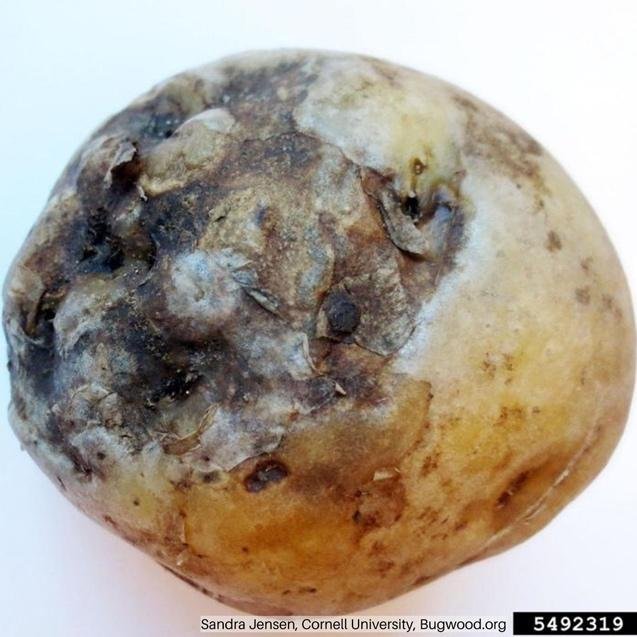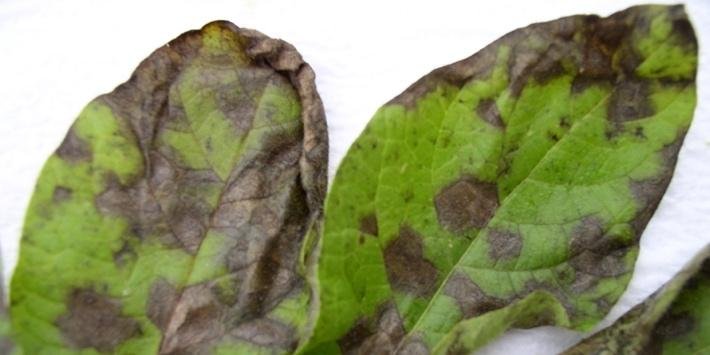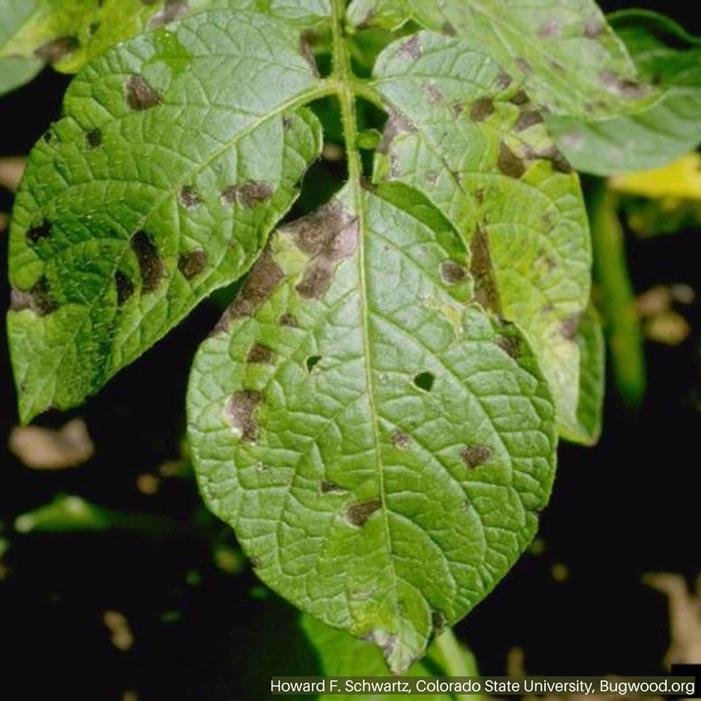Table of contents of the article
ToggleEarly blight is a fungal disease that affects potato leaves, causing brown spots and leaf damage. This article from the “WORLD OF PLANTS” website reviews methods for effective prevention and control of early blight on potato leaves.
Introduction to early blight on potato leaves
Disease name: Early blight of potatoes
Scientific name: Alternaria solani
Type of disease: fungal agent
Disease family: Pleosporaceae
Potatoes, a vital food source worldwide, face many challenges due to various diseases, and one of the prominent enemies is the disease known as early blight, which is caused by the fungal agent Alternaria solani. This article covers the disease life cycle, symptoms, causes, preferred conditions, and effective early blight control strategies, providing growers with essential knowledge to proactively manage the disease.
Life cycle of potato leaf blight
Understanding the life cycle of the fungal agent Alternaria solani is crucial for developing targeted control measures. The fungus is present in infected plants during the winter, where it serves as a source of potential infection in the next agricultural season. Under favorable conditions, spores are produced on infected plant debris and spread by wind, rain, or human activities. These spores can infect new potato plants, completing their life cycle.
Symptoms of early blight on potato leaves
Early blight, caused by the fungal agent Alternaria solani, exhibits distinct symptoms at different stages of infection, including a characteristic pattern often referred to as a “target.”
- Leaf spots: The disease begins with the formation of small, dark spots on older leaves. These spots often appear in a ring-textured pattern, providing a recognizable feature for early detection. These small, circular spots are the starting point for the progression of the disease.
- Target style: As the infection progresses, the spots develop to appear with a distinctive target-like appearance commonly known as a “target.” This pattern is characterized by a central dark brown or black area surrounded by annular rings of lighter colours, often yellow or light brown. The target pattern is a signature of early blight and helps growers distinguish it from other potato diseases.
- Yellowing of leaves and wilting: In advanced stages of infection, affected leaves show extensive yellowing and wilting, which is known as chlorosis. Severe infestations can lead to wilting and premature death of affected leaves, which greatly affects the overall health of the plant and contributes to reduced photosynthetic capacity.
Understanding these symptoms, especially the characteristic target pattern, is crucial for accurate and early diagnosis of early blight. Early detection allows for timely intervention and implementation of effective control measures with the aim of minimizing the impact on potato crops. Inspecting plants regularly and monitoring for these symptoms is an essential part of integrated disease management strategies.

Favorable conditions for early blight of potato leaves
Early blight shows distinct preferences for certain seasons and environmental settings, which affects its spread in potato crops.
- Seasonal preferences: Early blight is most prevalent during warm weather seasons, when temperatures between 20-30°C are favored. The disease tends to flourish in the spring and summer months when these thermal conditions are available. However, it can also persist into the fall under favorable conditions.
- Leaves wetness and humidity: The fungus thrives in environments with long periods of leaf wetness, which is usually caused by dew, rain or irrigation. High humidity levels, especially during warm temperatures, are an ideal environment for spore production and disease spread. So leaf management between periods of high humidity becomes vital to disrupt the infection cycle.
- Environment Preferences – Farmhouses vs. Open Fields: Early blight usually shows a preference for conditions in open fields rather than greenhouses. Natural air circulation in open fields, with warm temperatures, matches the environmental conditions that promote mushroom growth. Greenhouses, with tightly controlled environments and potentially high temperatures, may not be conducive to the development of early blight. However, good ventilation in greenhouse settings remains essential to reduce humidity levels and create less favorable conditions for disease development.
Understanding these seasonal and ecological preferences is essential to implementing effective preventive measures and control strategies. Growers can adapt their management practices based on expected conditions, providing a more targeted approach to mitigating the impact of early blight on potato crops.
Favorable conditions for early blight of potato leaves
Several factors contribute to the spread of early blight in potato crops.
- Contaminated tubers: Using infected potato tubers introduces the pathogen into the field, initiating the disease cycle.
- Favorable weather conditions: Warm and humid conditions during the growing season enhance pathogen activity, leading to increased infection rates.
- Poor crop rotation: Growing potatoes or other susceptible crops continuously in the same area facilitates the persistence of the pathogen in the soil.
Losses from early blight on potato leaves
Early blight can result in significant yield loss and impact on potato quality.
- Reduce production: The disease affects the metabolic capacity of the plant, resulting in reduced tuber development and decreased overall production.
- Low quality: Affected tubers may appear blotchy, affecting their market attractiveness and suitability for consumption or processing.



Strategy to combat early blight on potato leaves
Effective management of early blight involves a combination of cultural, chemical and preventive practices, including organic control.
- Agricultural practices: Practices such as crop rotation, timely removal of infected plants, and maintaining proper spacing between plants help reduce disease pressure.
- Chemical control: Fungicides play a critical role in early blight management. Fungicides used in various regions of the world include: chlorothalonil, iprodione, difenoconazole, cymoxanil, famoxadone, azoxstrobin, thiophanate methyl, pyraclostrobin, tebuconazole, mencozeb, and manip. These chemicals work by inhibiting the growth and reproduction of the fungus, providing effective control. Treatment should be timed according to disease progression and prevailing weather conditions.
- Organic control: For those who choose organic methods, there are alternatives that can help control early blight. Trichoderma polysporum and various bacteria have shown ability to control early blight. These biotic enemies work by competing with the pathogen for nutrients and space, as well as producing substances that inhibit fungal growth. Incorporating these agents into an organic management plan contributes to disease control in a sustainable and environmentally friendly manner.
Preventive measures for early blight of potato leaves
Effective prevention is key to mitigating the risk of early blight in potato crops.
- Use certified potato tubersStart with certified disease-free potato tubers to avoid introducing the pathogen into the field.
- Crop cycle: Rotate crops to break the disease cycle, reducing the persistence of the pathogen in the soil.
- Optimal irrigation: Irrigation management practices should avoid pooling of water on the leaves to reduce favorable conditions for spore emergence.
- Paper management: Uproot or cut off the lower leaves to improve air circulation, which reduces humidity and limits the spread of disease.
- Monitoring and early detection: Inspect plants regularly for symptoms, and remove and destroy infected plants quickly to prevent further spread.
- Covering the soil with mulch: Placing mulch around plants helps prevent water from spraying from the soil onto the leaves, which reduces the risk of infection.
By combining these preventive measures with chemical and organic control, growers can create a comprehensive early blight control strategy, ensuring the health and productivity of potato crops throughout their growing cycle.
Conclusion
Early blight, caused by Alternaria solani, poses a major threat to potato crops globally. By understanding its life cycle, symptoms and favorable conditions, farmers can implement targeted measures to protect their crops. Through a comprehensive approach that includes agronomic practices, chemical interventions and preventive measures, farmers can enhance the strength of potato crops against the devastating impact of early blight. Individuals in the agricultural sector must continue to share knowledge, strengthen collaboration, and empower farmers to combat plant diseases, to ensure a sustainable and productive future for potato farming.
In conclusion, we would like to note that we, at the world of plants website, offer you all the necessary services in the world of plants, we provide all farmers and those interested in plants with three main services::-
- Artificial intelligence consulting service to help you identify diseases that affect plants and how to deal with them.
- Blog about plants, plant diseases and care of various crops ... You are currently browsing one of her articles right now.
- An application that provides agricultural consultations to clients, as well as a service for imaging diseases and knowing their treatment for free – Click to download the Android version from Google Play Store، Click to download the IOS version from the Apple App Store.
Resources:
- Agrios, G. N. (2005). Plant Pathology. Elsevier Academic Press.
- Compendium of Ornamental Foliage Plant Diseases. (1998). APS Press.
- Potato Early Blight – A Guide for Integrated Management. (2008). The American Phytopathological Society.
- Alternaria solani: Understanding a Plant Pathogenic Fungus. (2015). Molecular plant pathology.
- Toth, I. K., van der Wolf, J. M., Saddler, G., Lojkowska, E., & Hélias, V. (2011). Chapter Four - Alternaria solani: Early Blight of Potato and Tomato. Advances in Applied Microbiology, 76, 1-40.
- Plantix – Early Blight of Potato
- Crop Protection Compendium. (2020). 'CABI.'
- Early Blight – agrio




